Bioengineered house plant acts as natural air-purification system
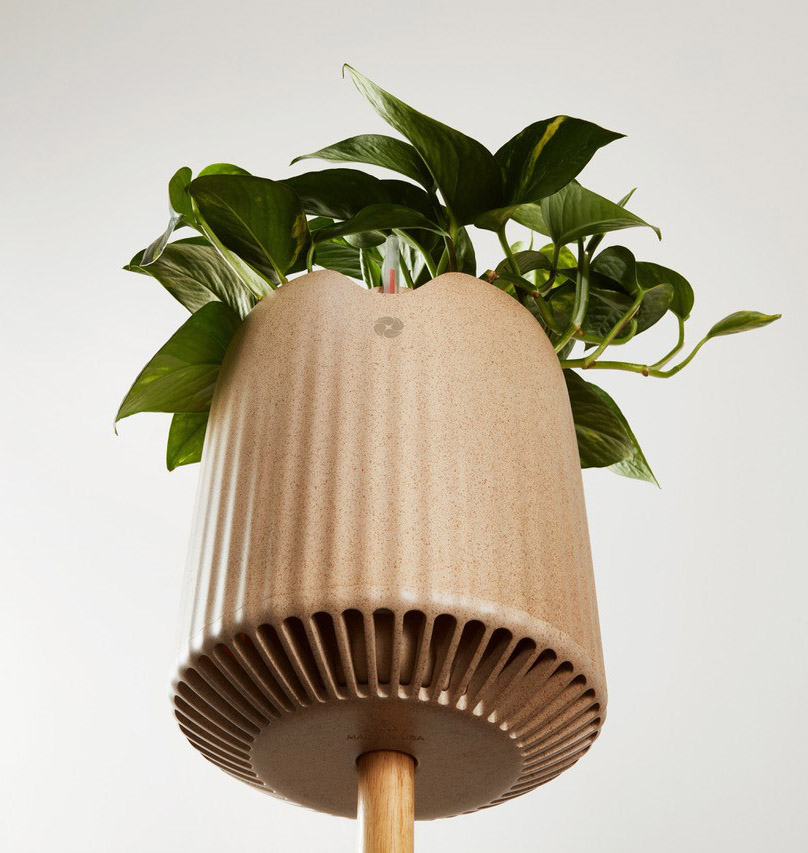
Chicago molder M4 Factory partnered with French startup Neoplants on novel project
A French startup called Neoplants has bioengineered a common house plant to maximize its ability to act as a natural air-purification system. At the same time, it worked with Chicago-area injection molder M4 Factory to create a complex, multipiece pot for these plants made from PLA bioresin mixed with flax polymer.
Called the Neo P1, the plant “is more effective than up to 30 of the most popular houseplants in capturing and recycling harmful VOCs from indoor air,” according to Neoplants. This particular plant species –– called Golden Pothos (or epipremnum aureum) –– is a beautiful trailing plant with heart-shaped leaves that tolerates low light and minimal watering. It’s the first of many that Neoplants intends to bioengineer.
Showcased at CES 2024
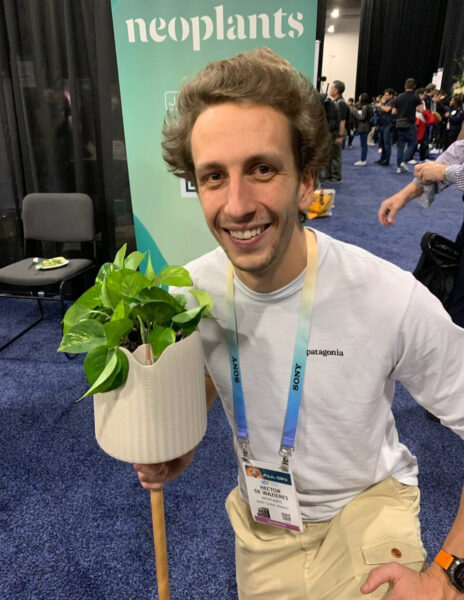
Neoplants’ Hector De Wazières shows off his firm’s new air-purifying house plant system at the CES 2024 show in Las Vegas. Photo by Robert Grace
In a Jan. 7 interview at the huge CES 2024 consumer technology show in Las Vegas, Hector De Wazières, the French firm’s chief of staff and product lead, said: “We’ve been working for more than a year now with M4 Factory to design this shell.”
He said they designed the polylactic acid (PLA) flax shell both to maximize airflow between the room and the plants and to include a water tank with a water level indicator that helps ensure the plant remains properly watered.
“We were looking for a partner who could produce this for us in the U.S.,” said De Wazières. “We wanted someone who would work with us to create a sustainable product, using sustainable materials. We’ve been working with M4 since day one –– first for choosing the material, then for producing the molds, and eventually for producing the final product.”
Neoplants specifically wanted to explore using recycled and bio-based resins to support the design of its “Shell” pot. M4 CEO Patricia Miller said that Neoplants “found us based on knowing we work in those materials and because of our material library.” The ideal material, she said, would maximize durability, while delivering the right aesthetic and story. It needed to be sustainable, water- and UV-resistant, have a natural “speckle” aesthetic, and be manufacturable.
Opting for flax
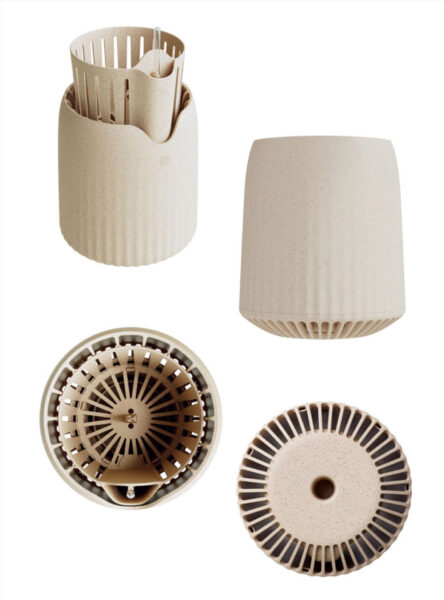
The plant shell, developed and produced by Chicago molder M4 Factory, consists of four detachable modules, all made from PLA flax. Courtesy M4 Factory
Miller –– the granddaughter of the 48-year-old company’s toolmaker founder –– says they considered three types of natural materials for the shell –– wheat starch, flax and hemp. They ended up choosing flax as the production material “based on its beautiful texture, suitability for the design and low carbon output.” De Wazières said his team also based its decision on pollutant emissions, and it analyzed every option in its lab.
Flax polymer is made from agricultural waste, and blended with other plant-based polymers to produce the optimal characteristics for manufacturing. As a domestically sourced material, it also offers a low carbon impact in shipping.
The pot consists of four detachable modules –– the outer layer, the water tank, the water level indicator and the inner basket. The parties designed it to maximize airflow between the outer layer and the inner basket by placing openings near the top and bottom of the planter.
“The outer layer contains a water tank and a water level indicator so that Neo P1 only needs to be watered once every two to three weeks,” Neoplants explains. “The basket holds the plant and keeps the soil hydrated thanks to the capillary water transfer through two small ropes running from the water tank to the soil.”
Planning to manufacture in the US
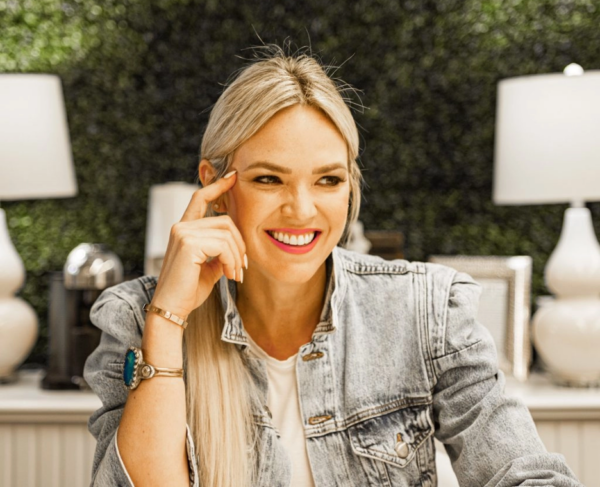
M4 CEO Patricia Miller stresses the texture, aesthetics, manufacturability and low carbon emissions of the PLA flax material chosen for the shell. Courtesy M4 Factory
De Wazières said that the pots on display at CES were the first to come out of the molds and Neoplants received them just the previous week. “The molds are still in China, but they are going to be shipped to the U.S. and used in the U.S. For now we just have one single pot, but we’re going to be working on pots for other plant species, as well, other colors.”
A 19-page white paper by Neoplants explains in depth the physiology of plants and the bioengineering it did to create the Neo P1. In it, the company explains: “Using a combination of molecular biology, plant physiology, metabolism and microbiome engineering, we create bioengineered plants that can effectively fight air pollution. Giving Nature the ability to remediate the pollution caused by petrochemical industries that end up in our lungs in the form of VOCs.”
Engineering the microbiome
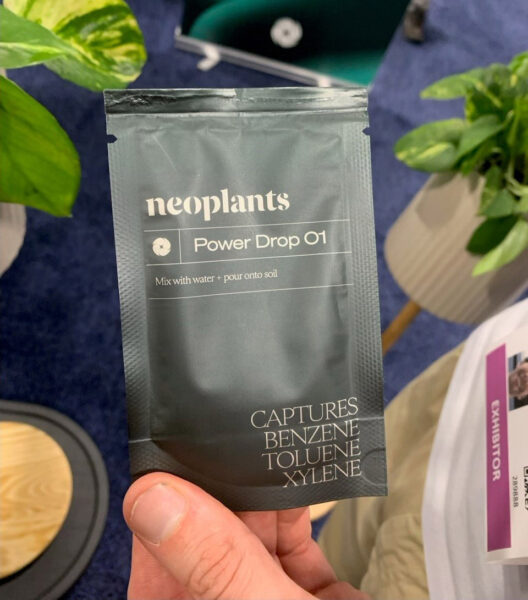
Plant owners need to mix these microbiomes with water and apply to the plant once a month to maintain its maximum air-purification powers. Photo by Robert Grace
The plant itself is only part of the solution, as each lives with a community of billions of beneficial fungi and bacteria, forming a microbiome that helps that plant thrive. This microbiome, mostly located in the soil near the plant root system, also has great potential to remediate VOCs. “Therefore, we engineered this community of bacteria, using directed evolution, to maximize the depollution efficiency of the biological system we call a ‘neoplant’.”
Plant owners will need to mix the microbiome –– called Power Drops –– with water and add it to the plant once a month. Neoplants provides the product in a small pouch. A wooden plant stand, the shell pot, the plant itself and a four-month supply of Power Drops costs $179.
“Our partnership with M4 Factory was pivotal in the successful launch of our product,” said De Wazières. “Their team was extremely helpful at every stage of the process, from the choice of materials, taking into account our various constraints, to large-scale production.”
